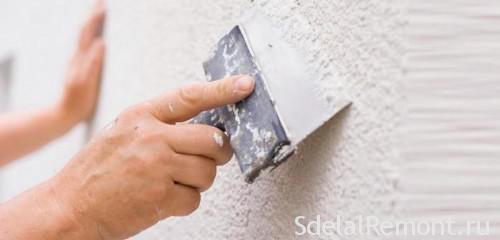Plastered of walls and ceilings in several steps: initially applied base layer, primer, then apply a finishing layer, sometimes by double Shpatlevanie. The upper layer of finish are presented the most essential requirements: it should be exactly the previous, and resistant to external influences. Besides, finishing coat should not consist of the filler fractions with more substances 0,5 mm.
Why finish plaster walls
Putty used for leveling walls indoors and outdoors. trained over

Nost used as the basis for other materials, eg, under the wallpaper or paintable. Finishing coat is a finishing, so it is important, that it has a smooth surface.
The desired properties are provided by fine grinding of the components of the material. It has the best quality finish putty, prepared from filler fines to 0,15 mm: when applied to the surface of the wall, it can not even grind. According to the chemical composition of filler virtually indistinguishable for the finishing work on the material for basic and intermediate shpatlevanija, the only difference is in the amount of material fractions.
The choice of fillings
All kinds of fillers, depending on the manufacturing material, divided into three groups:
- gypsum - its application is executed finish plaster walls in rooms with low humidity. Plaster - it is not water-resistant material, bathrooms, shower rooms, in the kitchen and bathrooms finish based on it will come quickly into disrepair. Advantages of plaster filler - no shrinkage and increased drying speed;
- cement - suitable for treating areas with high levels of humidity. It has improved water resistance, It has a small shrinkage during solidification;
- acrylic;
- Polymer - option for rooms with normal humidity. Well and dries quickly, firmly held on the wall surfaces. The minimum thickness of one layer of only the surfacing 0,2 mm. Prepared on the basis of polymers putties have only one drawback - a very high price.
The second important component of the putty - Lime. Important, to its size corresponds with the size fractions basics fractions, otherwise the mixture will turn out poor quality.
For self-repair facilities best suited polymeric filler. It has a high viscosity and has good adhesion, thereby finishing puttying walls will perform at the first attempt, even without possessing the necessary experience.
The technology of applying the finish plastering
Application of the finishing plastering is carried out only over starting or intermediate trim. The top thin layer of material must have a thickness of not more 1-3 mm, and, than it is thinner, all the better. Start working only a day later after, the previous layer material was applied.
Before applying the finish plaster, It is required to prepare tools - large and small spatulas. The first is suitable for decoration broadsides, and the second - for the hard to reach places. Putty is applied sweeping movements, spatula firmly pressed against the wall surface. The direction of motion spatula should not coincide with the direction, which was selected when creating the previous layer. For each treatment portion is carried out several times a tool, material layer to get a perfect smooth.
There is another application technique, that is, that the first filler is applied to the wall of short strokes into one reservoir. When it dries, controlling layer applied.
Stages and the order of work
The first stage - preparatory. Dry putty mixture is diluted with water for, to yield a solution desired consistency. To perform this job, use a special container of suitable size: first it is poured cold tap water, powder and then added in the proportion, that is listed on the packaging. The mixture was stirred using a mixer.
When rotating mixer blade will strike the container bead, and before, how to apply the finish plaster wall, in solution may show dirt particles, are there because of this fall. To avoid this, it is recommended to thoroughly wash the dishes before preparing the fillings. Also, do not use metal containers, because they can rust, and pieces of dross mixture will be. The best option - clean plastic utensils.
If you do not have time to prepare the material, in the hardware store you can buy already liquefaction mixture. It costs about 20% expensive, than dry powder. detail how to choose a ready-made filler.
The next step - applying putty directly on the surface of the wall. To do the job properly, It encouraged to review the educational video. The rollers on the specific examples shown, what a finish coat, and how to properly use.
Putty, having in its composition with a fraction of a compound 0,15 mm, after drying needs grouting. Usually used for this skin grain 150. The processing will be eliminated minor defects, which spoil the texture and surface appearance. If selected for repair putty, consisting of materials fraction less 0,15 mm, the additional finish, probably, need not: this material forms a homogenous plastic mixture, which upon drying forms a virtually defect.
Videos about fineshnoy plastered walls












